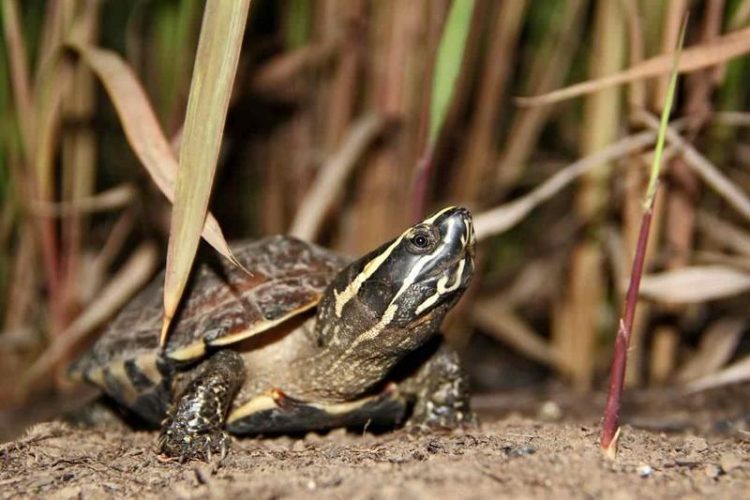New turtle discovered in Asia

Male specimen of the newly described species Malayemys khoratensis from Sikhio, northeastern Thailand. Foto: F. Ihlow
Using genetic and morphological analyses the team revealed the genus Malayemys to comprise three instead of two species as previously thought. The researchers examined more than 100 turtles from Mainland Southeast Asia.
The initial objective of this study was to determine whether the two recognized species represent genetically distinct species at all, as genetic analyses sometimes reveal putative species to actually represent a single morphologically variable species. Flora Ihlow, PhD student at the Herpetology Section of the ZFMK was particularly surprised when “genetic data unraveled a third, so far completely overlooked species”.
Further analyses demonstrated that the new species also differs in morphology. Each of the three species exhibits its own unique facial pattern, by which they can easily be distinguished. “Integrative approaches which combine morphology and modern molecular genetic techniques have become indispensable for the detection of new species” explains Prof. Dr. Uwe Fritz, head of Museum of Zoology, Senckenberg Dresden.
The genus Malayemys now contains three species of relatively small turtles with a maximum carapace length of 22 cm, which inhabit shallow water bodies across the Southeast Asian lowlands. These turtles seem to be fairly synanthropic and “with a little luck, one can spot turtles of the genus Malayemys in rice paddies, temple ponds, and canals even in the heart of big cities such as Bangkok or Siem Reap” says Ihlow.
According to Ihlow, “all three species are hunted and traded for food and religious purposes, which threatens the populations”. Nevertheless, the protective status of the two previously recognized species is low. “The description of the new species will require a re-evaluation of the protective status, since each species now has a smaller distributional range”, says Ihlow. Furthermore, future conservation measures such as conservation breeding and reintroduction programs will have to consider the new findings and choose their stock specimens accordingly.
The new species Malayemys khoratensis seems to be restricted to the eponymous Khorat Plateau in northeastern Thailand. “Hitherto, M. khoratensis is known from catchments of a few rivers only”, explains Timo Hartmann, also PhD student in the herpetology section of the ZFMK.
Publication
Ihlow, F., Vamberger, M., Flecks, M., Hartmann, T., Cota, M., Makchai, S., Meewattana, P., Dawson, J.E., Kheng, L., Rödder, D., Fritz, U. (2016) Integrative Taxonomy of Southeast Asian Snail-eating Turtles (Geoemydidae: Malayemys) unravels a new species and mitochondrial introgression. –PLoS One, DOI: 10.1371/journal.pone.0153108.
Contact:
Flora Ihlow
Sektion Herpetologie
Zoologisches Forschungsmuseum Alexander Koenig, Bonn
Tel. +49228 – 9122253
F.Ihlow@zfmk.de
Prof. Dr. Uwe Fritz
Senckenberg Naturhistorische
Sammlungen Dresden
Tel. +49351 – 795841 4328
Uwe.Fritz@senckenberg.de
Zoological Research Museum Alexander Koenig – Leibniz-Institute for Animal Biodiversity (ZFMK) is an independent research institute. The focus of research is on performing an inventory of the zoological species diversity on earth, on the analysis of changes in biodiversity as a result of environmental factors, and on evolutionary processes at the morphological and molecular levels. ZFMK furthermore explores the context of structure and function of ecological systems, advanced scientific methods, and the study of the history of science. The permanent exhibition “Our blue planet – the living network” offers a genuine nature experience based on naturalistic ecosystem displays.
The Leibniz Association is a network of 88 scientifically, legally, and economically independent research institutes and scientific service facilities. Leibniz Institutes perform strategic and thematically-oriented research and offer scientific service of national significance while striving to find scientific solutions for major social challenges.
Media Contact
More Information:
http://www.zfmk.deAll latest news from the category: Life Sciences and Chemistry
Articles and reports from the Life Sciences and chemistry area deal with applied and basic research into modern biology, chemistry and human medicine.
Valuable information can be found on a range of life sciences fields including bacteriology, biochemistry, bionics, bioinformatics, biophysics, biotechnology, genetics, geobotany, human biology, marine biology, microbiology, molecular biology, cellular biology, zoology, bioinorganic chemistry, microchemistry and environmental chemistry.
Newest articles

High-energy-density aqueous battery based on halogen multi-electron transfer
Traditional non-aqueous lithium-ion batteries have a high energy density, but their safety is compromised due to the flammable organic electrolytes they utilize. Aqueous batteries use water as the solvent for…

First-ever combined heart pump and pig kidney transplant
…gives new hope to patient with terminal illness. Surgeons at NYU Langone Health performed the first-ever combined mechanical heart pump and gene-edited pig kidney transplant surgery in a 54-year-old woman…

Biophysics: Testing how well biomarkers work
LMU researchers have developed a method to determine how reliably target proteins can be labeled using super-resolution fluorescence microscopy. Modern microscopy techniques make it possible to examine the inner workings…





















